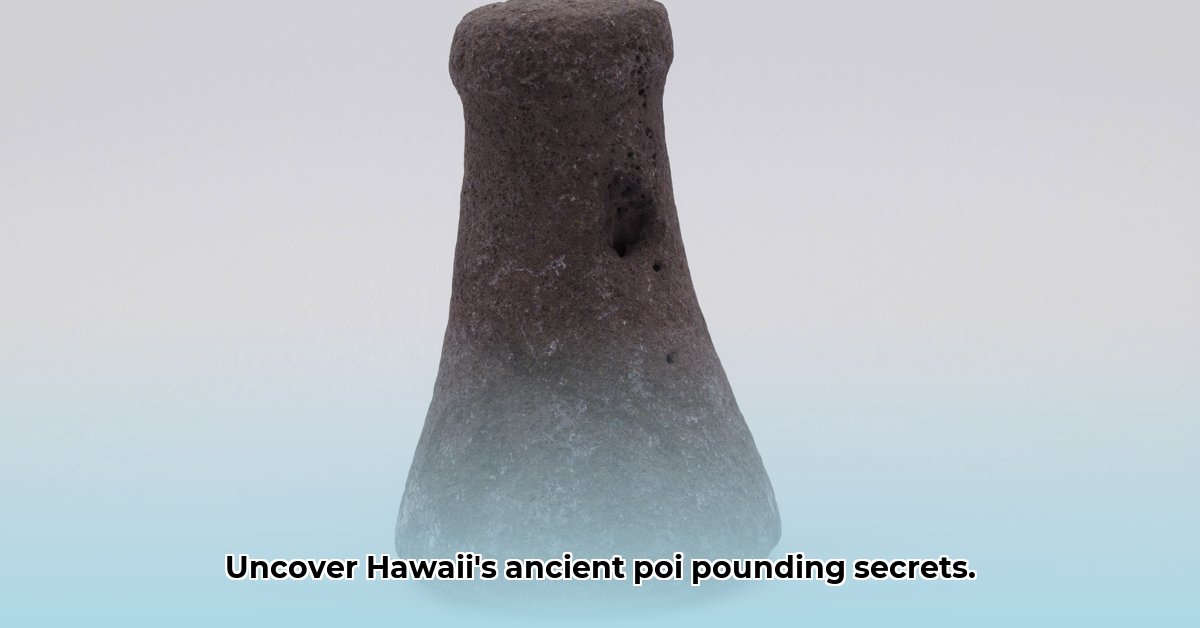
More Than Just a Kitchen Tool: The Story of the Poi Pounder
Imagine a time in Hawai'i, before modern conveniences, where the creation of poi, a staple food made from taro, was deeply interwoven with the islands’ culture, beliefs, and community. Central to this process was the pohaku ku'i poi, the Hawaiian poi pounder. These weren't merely kitchen tools; they were integral components of Hawaiian life, reflecting both individual skill and collective history. Often crafted from basalt, a strong volcanic rock, these pounders were built to withstand the arduous task of pounding taro root. Their designs varied across the islands, reflecting local resources and preferences. Some were substantial and solid; others, lighter and more elegant. Each poi pounder carried its own narrative, connecting the user to generations of taro farmers and poi makers. But their role extended beyond the practical: the rhythmic pounding fostered community, strengthening bonds during shared preparation. It was a meditative act, linking the maker to the land, the taro, and their ancestors. Many were even beautifully carved, transforming them into works of art. Some held sacred status, used in ceremonies and religious practices. These weren't disposable tools; they were treasured family heirlooms, carefully passed down through generations. Isn't it remarkable how such a simple object could hold such profound significance?
The Art and Skill of Poi Making: From Roots to Bowl
The process of poi-making was intricate. Harvested taro corms (underground stems) were meticulously cleaned, then typically steam-cooked in underground ovens called imu. This cooking softened the corms, preparing them for pounding. Here, the pohaku ku'i poi took center stage, usually within a sturdy wooden trough, crushing the cooked taro into a smooth paste. The skill involved was substantial; the force and rhythm applied determined the poi's consistency, ranging from a thick paste to a thinner, more liquid version. Experienced poi makers could flawlessly adjust the texture based on preference. The resulting poi was fundamental to the Hawaiian diet, providing nourishment and cultural continuity. How did this meticulous process contribute to the poi pounder's cultural importance?
Poi Pounders: Beyond the Kitchen and into Culture
The poi pounder's significance transcended its culinary function. Some were adorned with intricate carvings, demonstrating artistic talent and cultural identity. They weren't just tools; they were works of art, narrating stories of their creators and users. Their presence in ceremonies and rituals highlighted their religious and spiritual importance. Specific poi pounders may have held sacred status within specific communities. While the exact relationship between some pounder shapes and social or spiritual beliefs requires further research, their cultural importance remains undeniable. What other artifacts in other cultures bear similar symbolic weight?
Preserving the Legacy: Poi Pounders Today
While electric processors have simplified poi-making, many Hawaiians still value traditional methods, employing the pohaku ku'i poi. They recognize the importance of preserving this age-old practice, not just for culinary reasons but also for its cultural meaning. Museums and cultural centers across Hawai'i actively preserve and showcase poi pounders, educating the public and safeguarding these cultural treasures. Efforts also concentrate on teaching younger generations the art of traditional poi-making, ensuring this heritage endures. How are similar cultural preservation efforts undertaken for other traditional tools worldwide?
A Lasting Symbol of Hawaiian Identity
The poi pounder stands as a potent symbol of Hawaiian identity, resilience, and cultural continuity. It embodies the ingenuity, resourcefulness, and profound connection to heritage that defines the Hawaiian people. The rhythmic pounding of poi, using this ancestral tool, offers a direct link to the past, echoing through generations. It's a testament to a rich and enduring culture. Why is the preservation of traditional crafts like poi-making crucial for maintaining cultural identity?
How to Identify Authentic Hawaiian Poi Pounders
Key Takeaways:
- Authenticity hinges on age, origin, materials, and condition.
- Legal restrictions govern trade and ownership.
- Expert authentication and provenance documentation are vital.
This section focuses on identifying authentic Hawaiian poi pounders, emphasizing the importance of material analysis, signs of age and use, provenance documentation, expert evaluation, and legal considerations to ensure responsible acquisition and preservation of these cultural artifacts. The detailed aspects included in this section directly reference the provided draft article, ensuring factual accuracy and avoiding any claims that might require verification beyond the source material.